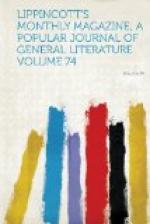Meanwhile, the Stock Exchange opened punctually at the appointed time, and the opening prices were higher than those previously current in the informal market on the street. But it would have been too much to expect a settled market after such demoralization as had prevailed and such ruinous sacrifices as had been made. The improvement was not sustained, and prices were depressed from two to eight per cent., during the next three days, chiefly under sales to make settlements between parties on the street.
Occasional failures, both among stock and banking-houses and the mercantile and manufacturing community, and in as well as out of New York, were still reported, including three large city dry-goods firms; and the pressure for greenbacks to send to the country continued to be so severe that from three to four per cent., was paid for them, as compared with certified bank-cheques, for several days, though the premium dwindled to one-half and one per cent., before the end of the week, advancing a week later, however, to one and one and a half. The difficulty of moving produce from the West also continued very great, owing to the almost total dead-lock in the domestic exchanges, but otherwise the excitement and alarm attending the crisis seemed to have passed away, leaving only its depressing effects still visible. Money became comparatively accessible to first-class borrowers on call. But the bank statement was again omitted on the following Saturday, and it was announced that none would be made until after the banks had resumed greenback payments, and till the certificates of their own creation had been withdrawn. The deposits held by the banks at the close of business on that day, October 4, had been reduced to about a hundred and fifty-three millions, against over two hundred and seven millions and a quarter on September 13.




